Media | Articles
Junk in the Trunk: Auto history’s leading rear ends
This article first appeared on this site in July 2022. We’re resharing it now to solicit your input: Which automotive rear ends would you add to this list? Drop a comment below and let us know. Who knows, we might compile Part Two. —Ed.
Despite the proliferation of video chat and Zoom calls in recent history, the fundamentals of interpersonal communication involves face-to-face interaction. When it comes to automobiles, we aren’t all that different. Manufacturers tend to design them “from the front,” as people digest and judge a car’s face above all else.
Rare is the vehicle for which the rear-end styling receives equal or additional consideration. In some ways it isn’t sensible, given that we are constantly looking at the backside of every car in front of us while driving in traffic. With that in mind, we’ve hand-picked a slew of significant vehicles that treated the rear with as much visual weight as the front.
1948 Cadillac
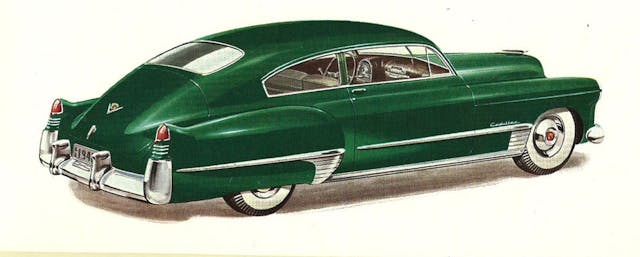
It may be difficult to believe, but Cadillac was not the top luxury brand in America before World War II. That would be Packard.
Cadillac slowly made its way toward overtaking Packard as America’s dominant luxury brand, starting in the late 1920s with compelling designs from Harley Earl and commensurately deft engineering innovations. By 1948, with styling cues copped from the twin booms of the P-38 Lockheed Lightning, Cadillac began a styling cue that would change how Americans (and the world) viewed personal transportation.
These humps (or lovely taillight lumps) were the genesis of what we’d later call “fins,” with the aeronautical influence evolving from airplanes to rockets as the 1950s progressed. Designer Bill Mitchell, a progenitor of this motif, later said, “From a design standpoint, the fins gave definition to the rear of the car for the first time. They made the back end as interesting as the front, and established a longstanding Cadillac-styling hallmark.” With the all-new high-compression V-8 for 1949, Cadillac arguably produced the first perfect American car of the postwar era and, by 1950, had overtaken Packard in the American automotive consciousness.
1957 Chrysler Corporation “Forward Look”
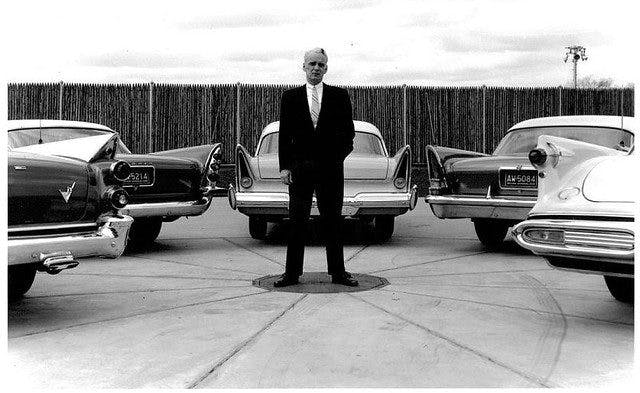
If 1955 was the year of the “Horsepower Race,” then 1957 certainly was the year of the fin. Notable protuberances had begun to appear in 1955 in some showrooms, but it wasn’t until 1957 that most manufacturers fully inhaled the waft of what Cadillac had been cooking. Out of all the brand offerings in 1957, it was Chrysler Corporation’s all-new “Forward Look” that asserted itself as the king of fins. From the front, they all looked like they were soaring; from the rear, they looked like they were ready to blast off.
Certainly there were many other reasons besides “Flight-Sweep” styling to appreciate the Forward Look: comfort, engineering, roadability, safety, and performance. In comparison to other brands, Forward Look designs appeared cohesive, as if they had high upswept rear fins from birth. All one has to do is compare a 1957 Plymouth with the evergreen Chevrolet (with fins that practically seemed like an afterthought) and there was no contest; the Chevy was headed to the drive-in while the Plymouth was headed to the moon. It wouldn’t be until 1959 that General Motors would have vehicles that rivaled the Chrysler Corporation in style, especially from behind.
1963 Chevrolet Corvette
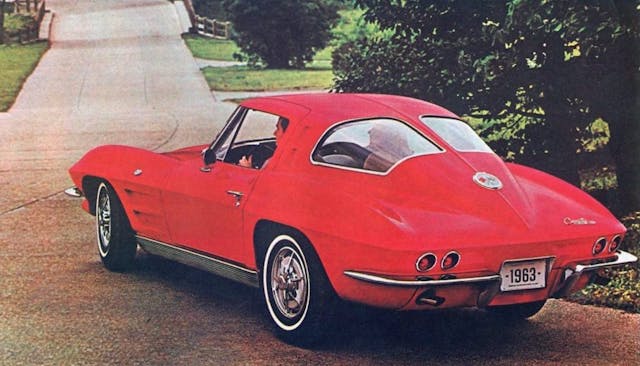
The Corvette always reflected among the best that General Motors had to offer in terms of styling in the 1950s, but when the second-generation “C2” debuted in the fall of 1962, mouths were agape. In particular, the bisected rear window on the ’63 became a controversial trademark but, even without it in years that followed, the rear view’s impact was as spectacular—if not more so—as the rest of the car. Underneath, an all-new independent rear suspension upped the sophistication quotient to a level for engineer and director of high performance, Zora Arkus-Duntov, to remark, “For the first time I now have a Corvette I can be proud to drive in Europe.”
The genesis of the 1963 Corvette comes from Bill Mitchell’s vision for an Italian-influenced sports car for Ed Cole’s Q-Chevrolet project. Peter Brock’s design for the Q-Corvette model won out, but the project never made it to production. All was not lost, however, as Larry Shinoda took inspiration from the Q-Corvette and came up with the 1959 Stingray Racer concept for Bill Mitchell. Thanks to critical acclaim and racing success (a highlight was winning the SCCA National Championship the following year), it became clear the Stingray Racer would determine styling cues for the C2. The rear design, influenced by the 1930s Bugatti Type 57SC Atlantic, pulled everything together to create one of the great postwar cars, especially from behind.
1971 Buick Riviera
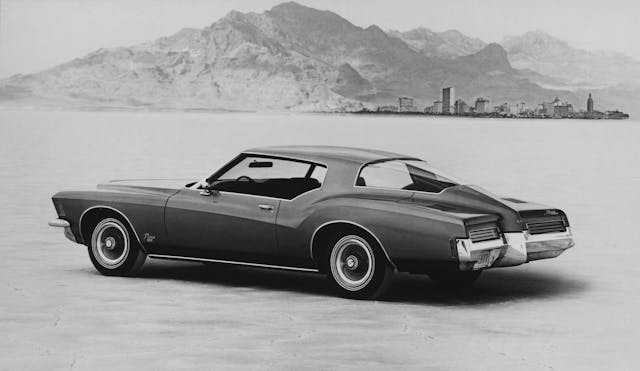
Notice a pattern here? Bill Mitchell brought back the Riviera’s verve for 1971 after losing its style leader status over the previous few model years. The new Riviera returned as an eye-catching chariot that featured inspired, neoclassical boattail styling, which was both distinctive and polarizing for some—even within Buick. General Manager Lee Mays publicly called it, “A classic new design that is a triumph of automotive styling,” but privately he said, “Sure, people liked it, some people like anything. I never could find anyone who admitted they designed it.”
Designer Jerry Hirschberg had a different take: “At first it was supposed to be on a [stretched, mid-size] A-body [platform, like a Grand Prix and Monte Carlo]. But then it was moved to the [full-size] B-body, and that didn’t help. On a smaller car, it could have been kind of interesting … the car looked slightly eccentric. But so would a Corvette if it were the size of a Cadillac.”
And from the horse’s mouth, Bill Mitchell said in retrospect that “What hurt the boattail was to widen it. It got so wide, a speedboat became a tugboat.” Such is the creative process but, to those of us who were not insiders, the 1971 Riviera represented style that had cast off any connection to the 1960s. Nowhere else was it better demonstrated than in the boattail rear. Perhaps the Riviera didn’t end up the way as intended, but its bodacious booty set the tone for the rest of the car.
***
Marketplace
Buy and sell classics with confidence
Check out the Hagerty Media homepage so you don’t miss a single story, or better yet, bookmark it. To get our best stories delivered right to your inbox, subscribe to our newsletters.







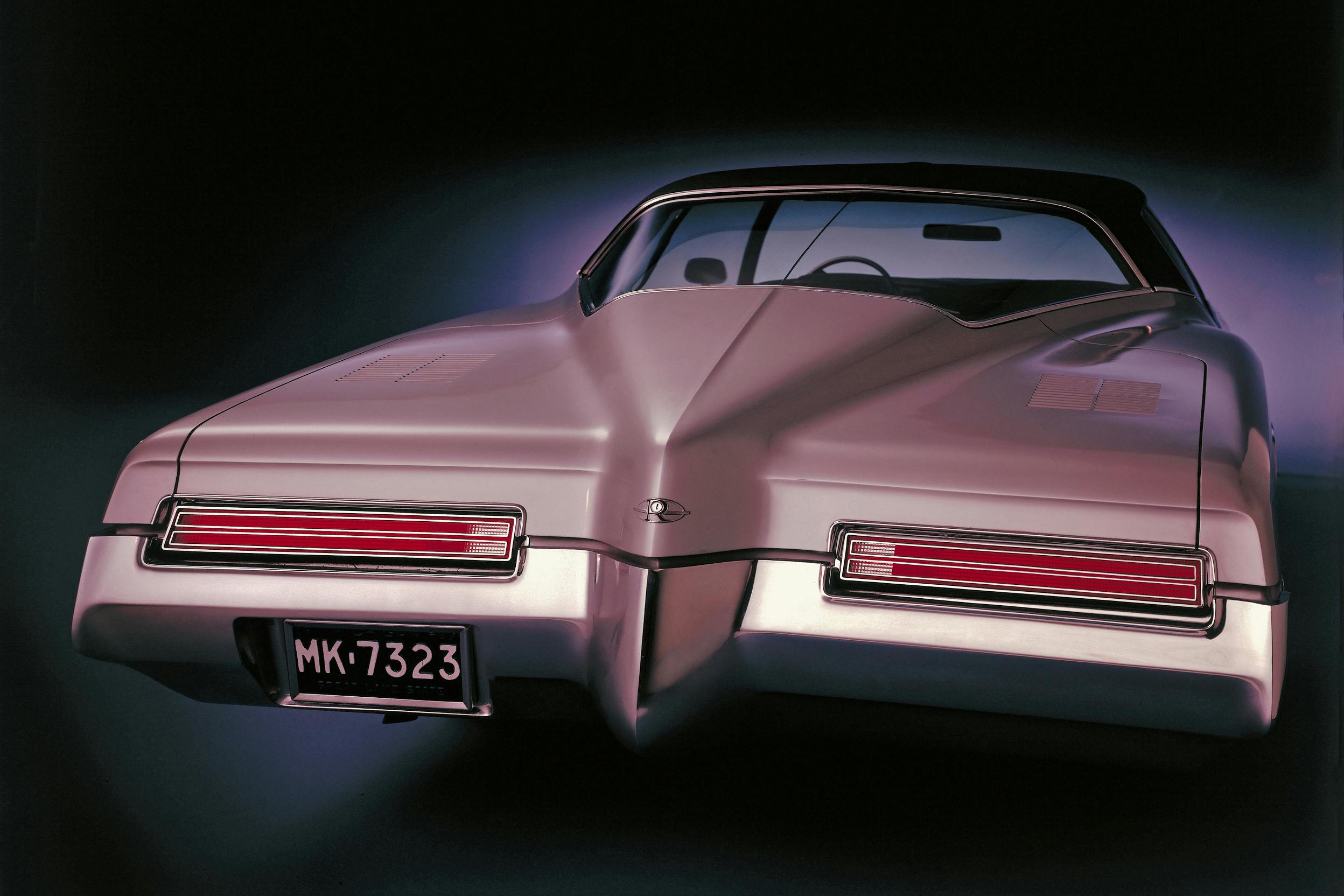
I certainly don’t disagree with any of the original selections. Can’t really say that there is any glaring omission, but I will say that plenty of people comment on the famous 6-slotted (or slitted?) taillights and kicked-up corners of the 1966 GTO tail panel. It’s not as distinctive as the article’s examples, but it’s interesting, a little risqué, and very recognizable.
In my oppinion, one glaring omission would be the Chrysler Crossfire.
Very shapely rearend, and the spine set’s it all into place.
https://www.google.com/url?sa=i&url=https%3A%2F%2Fwww.caranddriver.com%2Freviews%2Fa15132578%2Fchrysler-crossfire-srt-6-road-test%2F&psig=AOvVaw1ebG7Y_jf0KRNljCkYkUHL&ust=1698179204102000&source=images&cd=vfe&opi=89978449&ved=0CA8QjRxqFwoTCJCz99uAjYIDFQAAAAAdAAAAABAN
Looks like a Chrysler Sebring and VW New Beetle mated.
And in profile someone said it looks like two dogs humping.
Not a balanced or cohesive design.
Following up on Bostwick9’s comments; I will add that the pre-’53 VW Beetle’s split window rear end is both an elegantly designed posterior and completes the symmetry of its bilaterally symmetrical center-cleft form (and mimics the ‘wings’ of the Egyptian scarab that inspired the original “bug”)…
Collectors also prize that particular model/era!
If you like the Crossfire, you would love the Rambler Marlin, which preceded it with the same rear end styling cues by about 40 years or so. I’m a little surprised that the Marlin did not make this list.
Yep – I always thought the Crossfire coupe (though not the convertible) looked like a smaller Marlin – especially the 1967 version.
Crossfire??!! Surely you’re joking. A better name would be Misfire. …and the styling is part of the reason it failed.
Agree and would add first generation Toronados.
Agree. 1966 GTO rear styling for exactly the same reasons described. Similarly, the 65 and 66 Grand Prixs were also great rear end styling: clean, full-width taillights louver type with nearly invisibe red lenses along with the kicked-up corners.
I always felt that the 1967 GTO rear-end was much more sleek and attractive than the 1966. Just a matter of taste, I guess.
The Auburn boat tail speedster was not the first to use the style but is still the best known and copied.
As for Pontiac the rear end always had something special over the years. Even in the Trans Am the black out tail lamps that even carried over to the Fiero were classic. The GTO wing that wrapped into the fenders and later the Fiero.
The use of the Corvette round tail lamps in many of the other Chevy models gave them a family look. Even the Corvair lamps ended up on the first GT40 from Shelby.
’59 Buick Invicta/Electra 225… my boss had one when I worked at the gas station.
yes and also the 1960 buicks…such an uplifting elegant design
I’d add the ’53-’57 Oval window VW Beetle with it’s lovely little snowflake lens tail lights, beautiful “W” deck lid, and that perfectly styled oval window.
Not an American car
Who said that it has to be an American car?
Excellent choice. An unmistakable automobile from any angle.
The rear end of the 1980-1985 Cadillac Seville was like nothing else… until Lincoln and Chrysler copied it.
Itself a variation of the Rolls Royce.
We had a Seville. I still love the rear end. I would buy, tomorrow, a perfect one.
The most beautiful rear end, in my opinion, is the Pantera.
Was my choice too!
Shelby Daytona Coupe.
Oh yeah, that’s a good one!
1960-62 Valiant/Lancer has a certain elegance when seen from the back. The sloping rear deck and horizontal fins work well together. And then there is the optional ‘toilet seat’ on the trunk lid…
Ivan has it right. The 60 – 61 Valiants had unique styling with the cats-eye tail lights, horizontal fender fins, sloped rear window that flows into the trunk lid, with the pseudo-spare (toilet seat).
Not bad for a compact car, compare it to the 60 Corvair and Falcon. … Yuuck !
Indeed, and the used V-100 I took to college had a 3-speed stick on the floor….very continental, to match the spare tire.
But the following year, I had a 61 Plymouth (Savoy?) and those Exner’s after-thought tailights tacked onto the SIDES of rear quarter panels were certainly a unique anti-fin come-down.
https://motorcities.org/images/SOTW_1-15-2020/1961_Plymouth_magazine_ad_Chrysler_Archives_6.jpg
I like almost any Dodge Coronet tail light set, in the mid to late 60’s. all looked wonderful.
Ditto the ’66 Pontiac Lemans cat’s eye tail light.
In my opinion a 1968 Oldsmobile Cutlass has one of the best rear ends I’ve seen on a vehicle. The smooth flat trunk with slivers for tail lights and the smooth swooping rear bumper, just beautiful!
The 1966 Dodge Charger had an unmistakable taillight panel, echoed by the ’69 car.
The simplicity of a 1970 ‘Cuda.
Oh, Yeah! ’70 ‘Cudas are simple and beautiful at the same time.
59 El Camino Hands down. For God’s sake they made posters about it.
Also known as the MOTHER SHIP of elco’s
First generation Plymouth Barracuda, that back window was amazing but oh so hard to clean.
Hard to believe this article didn’t include those huge rear windows in the first generation Barracuda’s! They were quite unique and made a huge statement. A stellar rear end. Like my wife’s.
Are you saying your wife’s rear end makes a huge statement?
Touché 👏👏👏
Joe DiMaggio is supposed to have said the only two things that looked better from the rear than the front were the cathedral of Notre Dame and Marilyn Monroe.
Agreed – love the look of my ’66 Fish
No Gremlin?
I loved the four I had, one even had a V8.
No.
Many of the 1970s era Firebird Trans Am. Particularly the 1972 and the 1979. Back then, I thought these were the pinnacle of cool since I could not afford a Trans Am.
1967 Mercury Cougar should be added to the list . Those sequential tail lights were gorgeous
I agree, but we might not convince everybody. The Cougar rear was less assertive/aggressive than several choices on the list but more elegant IMHO.
I have a 1969 Mercury Cougar XR7 hard to beat early Cougars
Good call!
I believe you left out the top contender, 1959 Chevy Bat Wing rear end
Agreed had a 67 now have a 1968. Obviously I am prejudiced. 65 T Bird not bad at all either.